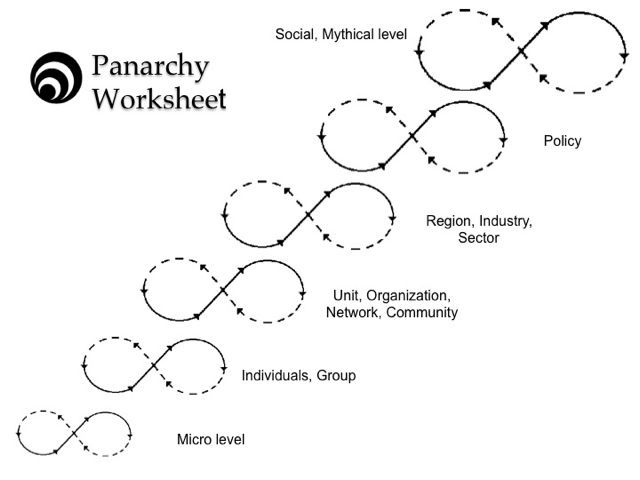Panarchy

Understand how embedded systems interact, evolve, spread innovation, and transform
Overview
Panarchy is an ideal tool for larger groups to identify together how systems are embedded within each other and their inter-dependencies. Participants become more observant of small changes that can help spread ideas to other groups and departments. Each level has dynamics at play that create ‘opportunity windows’ for multi-level movement across boundaries.
How to use it
- Identify a mix of strategies at multiple levels to move transformation efforts forward.
- Create an opportunity for people from many different levels to work together.
- Identify people who span levels and can help groups move forward.
- To help a whole group see the whole picture.
- Create resilience and absorb disruptions by reorganizing together.
How to apply it
Start:
Participants identify what is contributing to a challenge at levels above and below their own, then specify different strategies and opportunities for change within and across multiple levels.
Materials:
A room with an open flat wall for participants to stand in front of, individual Panarchy chart handouts, a large wall poster or flip chart version and sticky notes.
Time/Steps:
- 5 minutes: Introduce the idea of the Panarchy (and Ecocycle Planning if needed) and hand out a blank Panarchy chart to each participant.
- 5 minutes: Invite each person to generate a set of levels that influence the spread of their ideas/innovations by asking “What are the smallest-to-the-largest factors influencing your chances for success?”
- Include micro (particles, individual people, teams), meso (organizations, networks), and macro (culture, politics, myths) factors that contribute to the existence of the challenge you are addressing.
- 10 minutes: In pairs, participants “translate” the factors into levels and create labels for them (4-7 levels are sufficient).
- 10 minutes: In groups of four, participants compare levels and finalize one chart with sticky notes.
- 10 minutes: If there are multiple groups, create a single chart, by inviting each group to place any levels not previously included on the larger chart.
- 10 minutes: In groups of four reflect on the following set of questions: “Which levels have we invested our attention and resources in to date? Which levels have we neglected? What do we know about the status and dynamics in play at the different levels?”
- In the whole group, share reflections from a few groups.
- 15 minutes: In groups of two or four, explore one level in depth using Ecocycle Planning. Each group should pick one of the 4-7 levels, and have a person in their group who has experience at that level.
- The groups formulate answers for, “At this level, what is going on right now and what actions are being taken for the challenge that our innovation addresses? Is the response to the challenge in an entrepreneurial, bureaucratic, heretical, or renewal phase?”
- Create a rough draft of Ecocycle assessments for this scale.
- 10 minutes: Collect the assessments from the groups. Each level presents their assessment briefly.
- 15 minutes: Brainstorm a list of obstacles and opportunities in regard to the efforts across levels and ask, “Looking up and down the levels, what opportunities and obstacles do you see for changes across the levels? Are windows for new ideas opening above, are resources flowing downward from creative destruction unfolding above, are small scale developments from below disrupting the scale above?”
- 10 minutes: Use quick rounds of 1-2-4-All with questions such as: “What action can you take to influence levels above and below you?” And “Who do you know that has influence in more than one level simultaneously?”
- 10 minutes: Prioritize the opportunities and obstacles that emerge. For each, create one first action step.
- 15 minutes: Share actions steps with the whole group by placing sticky notes on each level of the large Panarchy chart.
- 15 minutes: In the whole group, use an After Action Review to simultaneously devise and prioritize possible next steps. Return to Panarchy as you continue work to spread your innovation.
How to adapt it
- Natural fit with Ecocycle Planning, 1-2-4-All, What I Need From You (WINFY), Social Network Webbing maps.
- After Action Review can help spur focused action steps
Tips
- Include people or perspectives from each level for more effective activity results.
- Research is useful when you are unfamiliar with dynamics at smaller and bigger levels.
- Note history and its role in defining what is possible at each level.
- Remind participants that innovations are made of layers, often not invented simultaneously as a system or at the same level. If you want to build robust solutions that spread across levels, you can go up one layer (generalize) by asking “What is this a part of?” or go down one layer (get more specific) by asking “What is a part of this whole?” If the focus is on new behaviours, “go up one layer” by asking “What intention is behind this behaviour?” and “go down a layer” by asking “what other behaviour is consistent with this intention?”
Resources
- To learn more see Professor Frances Westley’s contributions to the SIG Knowledge Hub on scaling and in the book “Panarchy: Understanding Transformations in Human and Natural Systems” and other writing.





